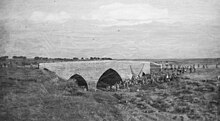






Jisr IsdudorIsdud Bridge, also known as the Ad Halom Bridge,[1][2] was a 13th century Mamluk bridge built over the Lakhish River (Wadi Sukrir/Wadi Fakhira).[2] It is located approximately 1.5 km north of the Ad Halom junction.[1] The bridge is similar in style and history to the nearby Jisr Jindas and Yibna Bridge.[3]
The bridge is used today by pedestrians and cyclists.[3]
It is made of dressed kurkar stones, with three lancet arches. According to the Archaeological Survey of Israel, the south arch "reveals earlier masonry work, perhaps from the Mamluk period, if not earlier. Flooding in the wadi exposed remains of ancient buildings, built of dressed kurkar stones, near the NW section of the bridge."[1]
The bridge was a tactical location in the 1917 Battle of Mughar Ridge. It was blown up in 1946 by the Haganah in the Night of the Bridges, and again in 1948 by the Golani Brigade in early stages of the 1948 Arab–Israeli War.[3]
It was subsequently reconstructed and upgraded, and carried heavy traffic for many years. In 2010 it was upgraded with archaeological support led by preservation architect Saadia Mendel. The concrete middle arch was dismantles and rebuilt using Mamluk-era techniques.[3]
The Ad Halom interchange south of Ashdod is known to most Israelis for its heavy traffic jams twice a day…. The Mamluks… established… three stone bridges surviving until today: near Yavneh, near the northern entrance to Lod, and the Ad Halom bridge over the Lachish stream. The three were built from local sandstone and have the same design - three pointed arches with the central one slightly taller than the other two… In June 1946, it was blown up by the Palmach during the "Night of the Bridges". Two years later, in the War of Independence, the bridge was blown up again, by a Golani Brigade unit, to stop the Egyptian army's advance… The operation's success led to the renaming of the bridge from "Gisser Asdud" (Ashdod Bridge) to "Ad Halom" (up to this stage). After the war, the bridge was restored without any attention to its historic significance and without any attempt to preserve the ancient stonework. For years, it carried heavy motorized traffic, until being replaced a few years ago by a modern interchange. The road company decided to use the opportunity to restore it again, this time in accordance with strict preservation codes. The Antiquities Authority dismantled the concrete middle arch, and rebuilt the bridge using the same technique as the Mamluks. The project was led by veteran preservation architect Saadia Mendel… The bridge will now be used by pedestrians and cyclists.
31°46′00″N 34°39′58″E / 31.76667°N 34.66611°E / 31.76667; 34.66611